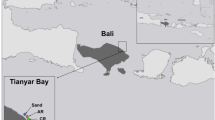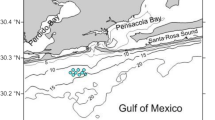Abstract
Net pen fish farms generally enrich the surrounding waters and the underlying sediments with nutrients and organic matter, and these loadings can cause a variety of environmental problems, such as algal blooms and sediment anoxia. In this study we test the potential of biofiltration by artificial reefs for reducing the negative environmental impacts surrounding fish farms in the Gulf of Aqaba, Red Sea. Two triangular-shaped artificial reefs (reef volume 8.2 m3) constructed from porous durable polyethylene were deployed at 20 m; one below a commercial fish farm and the other 500 m west of this farm in order to monitor the colonization of these reefs by the local fauna and to determine whether the reef community can remove fish farm effluents from the water. Both reefs became rapidly colonized by a wide variety of organisms with potential for the removal of compounds released from the farms. Within the first year of this study fish abundances and the number of species reached 518–1185 individuals per reef and 25–42 species per reef. Moreover, numerous benthic algae; small sessile invertebrates (bryozoa, tunicates, bivalves, polychaetes, sponges, anemones) and large motile macrofauna (crustaceans, sea urchins, gastropods) settled on the reef surfaces. Depletion of chlorophyll a was measured in the water traversing the artificial reefs in order to assess the biofiltration capacity of the associated fauna. Chlorophyll a was significantly reduced to a level 15–35% lower than ambient concentrations. This reduction was greatest at intermediate current speeds (3–10 cm s−1), but was not influenced by current direction. The reef structures served as a successful base for colonization by natural fauna and flora, thereby boosting the local benthic biodiversity, and also served as effective biofilters of phytoplankton.
Similar content being viewed by others
References
Angel, D. L., P. Krost & H. Gordin, 1995. Benthic implications of net cage aquaculture in the oligotrophic Gulf of Aqaba. Eur. Aquacult. Soc. Spec. Publ. 25: 129–173.
Angel, D. L., A. Post, S. Brenner, N. Eden, T. Katz, A. Cicelsky & I. Lupatsch, 1998. Environmental impact assessment of the Ardag net cage fish farm on the northern Gulf of Aqaba. A report prepared for the Ardag Fish Company, Israel: 95 pp. (in Hebrew).
Angel, D. L., S. Verghese, J. J. Lee, A. M. Saleh, D. Zuber, D. Lindell & A. Symons, 2000. Impact of a net cage fish farm on the distribution of benthic foraminifera in the northern Gulf of Eilat (Aqaba, Red Sea). J. Foram. Res. 30: 54–65.
Barnes, R. D., 1980. Invertebrate Zoology. 4th edn. Saunders College, Philadelphia: 1089 pp.
Beveridge, M. C. M. 1996. Cage Aquaculture. 2nd edn. Fishing News Books, Oxford: 346 pp.
Black, K. B., 1998. The environmental interactions associated with fish culture. In Black, K. D. & A. D. Pickering (eds), Biology of Farmed Fish. Publ, CRC Press, New York: 284–326.
Brenner, S., Z. Rosentroub & Y. Bishop, 1988. Current measurements in the Gulf of Elat. Israel Oceanographic & Limnological Research (IOLR) Report H3/88: 38 pp.
Brenner, S., Z. Rosentroub & Y. Bishop, 1989. Current measurements in the Gulf of Elat 1988/89. IOLR Report H8/89: 31 pp.
Chopin, T. & C. Yarish, 1998. Nutrients or not nutrients? World Aquacult. 29: 31–36.
Enell, M., 1995. Environmental impact of nutrients from Nordic fish farming. Water Sci. Technol. 31: 61–71.
Fishelson, L., 1971. Ecology and distribution of the benthic fauna in the shallow waters of the Red Sea. Mar. Biol. 10: 113–130.
Folke, C. & N. Kautsky, 1989. The role of ecosystems for a sustainable development of aquaculture. Ambio 18: 234–243.
Genin, A., G. Gal & L. Haury, 1995. Copepod carcasses in the ocean. II. Near coral reefs. Mar. Ecol. Prog. Ser. 123: 65–71.
Glynn, P. W., 1973. Ecology of a Caribbean coral reef. The Porites reef-flat biotop: Part II. Plankton community with evidence for depletion. Mar. Biol. 22: 1–21.
Golani, D. & A. Diamant, 1999. Fish colonization of an artificial reef in the Gulf of Elat, northern Red Sea. Envir. Biol. Fish. 54: 275–282.
Gowen, R. J. & N. B. Bradbury, 1987. The ecological impact of salmonid farming in coastal waters: a review. Oceanogr. mar. biol. Ann. Rev. 25: 563–575.
Gowen, R. J., D. P. Weston & A. Ervik, 1991. Aquaculture and the benthic environment: a review. In Cowey, C. B. & C. Y. Cho (eds), Nutritional Strategies and Aquaculture Waste. University of Guelph Press, Guelph, Canada: 187–205.
Greene, L. E. & W. S. Alevison, 1989. Comparative accuracies of visual assessment methods for coral reef fishes. Bull. mar. Sci. 44: 988–912.
Hamner, W. M., M. S. Jones, J. H. Carleton, I. R. Hauri & D. McB. Williams, 1988. Zooplankton, planktivorous fish and water currents on a windward reef face: Great Barrier Reef, Australia. Bull. mar. Sci. 42: 459–479.
Handy, R. D. & M. G. Poxton, 1993. Nitrogen pollution in mariculture — toxicity and excretion of nitrogenous compounds by marine fish. Rev. Fish Biol. Fisheries 3: 205–241.
Holmer, M. & E. Kristensen, 1992. Impact of marine fish cage farming on metabolism and sulfate reduction of underlying sediments. Mar. Ecol. Prog. Ser. 80: 191–201.
Kiflawi, M. & A. Genin, 1997. Prey flux manipulation and the feeding rates of reef-dwelling planktivorous fish. Ecology 78: 1062–1077.
Laihonen, P., J. Hännunen, J. Chojnacki & I. Vuorinen, 1996. Some prospects of nutrient removal with artificial reefs. In Jensen, A. C. (ed.), Proceedings of the 1st EARRN (European Artificial Reef Research Network). Ancona, Italy: 85–96.
Lupatch I. & G. W. Kissil, 1998. Predicting aquaculture waste from gilthead seabream (Sparus aurata) culture using a nutritional approach. Aquat. Living Resour. 11: 265–268.
Manahan, D., 1990. Adaptations by invertebrate larvae for nutrient acquisition from seawater. Am. Zool. 30: 147–160.
Manahan, D., S. H. Wright, G. C. Stevens & M. A. Rice, 1982. Transport of dissolved amino acides by the mussel, Mytilus edulis: demonstration of net uptake from natural seawater. Science 215: 1253–1255.
Naylor, R. L., R. J. Goldburg, J. H. Primavera, N. Kautsky, M. C. M. Beveridge, J. Clay, C. Folke, J. Lubchenco, H. Mooney & M. Troell, 2000. Effect of aquaculture on world fish supplies. Nature 405: 1017–1024.
Parsons, T. R., M. Takahashi & B. Hargrave, 1977. Biological Oceanographic Processes. Pergamon Press, N.Y.: 332 pp.
Parsons, T. R., Y. Maita & C.M. Lalli, 1985. A Manual of Chemical and Biological Methods for Seawater Analysis. Pergamon Press, N.Y.: 173 pp.
Reiss Z. & L. Hottinger, 1984. The Gulf of Aqaba: Ecological Micropaleontology, Springer-Verlag, Berlin: 354 pp.
Reiswig, H. M., 1985. In situ feeding in two shallow-water hexactinellid sponges. In Rutzler, K. (ed.), New Perspectives in Sponge Biology. Smithsonian Institution Press, Washington, DC: 504–510.
Salmon Aquaculture Review, 1998. Environmental Assessment Office, British Columbia, Canada: 1500 pp.
Welschmeyer, N. A., 1994. Fluorometric analysis of chlorophyll a in the presence of chlorophyll b and phaeopigments. Limnol. Oceanogr. 39: 1985–1992.
Weston, D. P., 1990. Quantitative examination of macrobenthic community changes along an organic enrichment gradient. Mar. Ecol. Prog. Ser. 61: 233–24.
Yahel, G., A. F. Post, K. Fabricius, M. Dominique, D. Vaulot & A. Genin, 1998. Phytoplankton distribution and grazing near coral reefs. Limnol. Oceanogr. 43: 551–563.
Author information
Authors and Affiliations
Rights and permissions
About this article
Cite this article
Angel, D.L., Eden, N., Breitstein, S. et al. In situ biofiltration: a means to limit the dispersal of effluents from marine finfish cage aquaculture. Hydrobiologia 469, 1–10 (2002). https://doi.org/10.1023/A:1015531812259
Issue Date:
DOI: https://doi.org/10.1023/A:1015531812259




